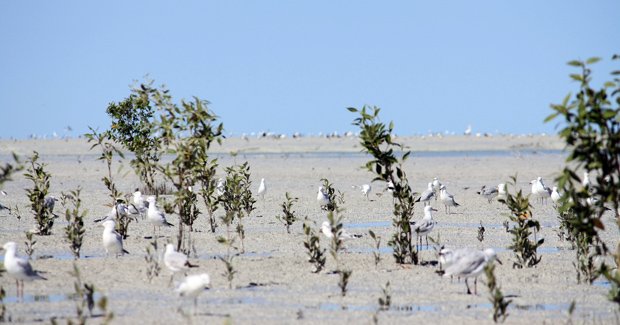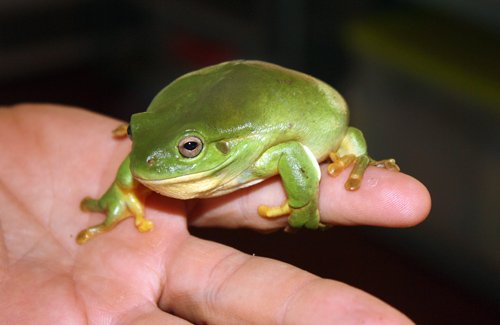Broome’s bewildering Bird Observatory

IN THE SHADEHOUSE OF the Broome Bird Observatory, serenity is typically the prevailing mood. This flyscreened dining area, 25 kilometres east of Broome on the shores of Roebuck Bay, is a haven where twitchers, volunteers and day trippers at one of Australia’s birding hotspots gather to enjoy a quiet cuppa and escape the heat. That is, unless nature intervenes.
“Look at the frog!” cries a delighted visitor, pointing up at a dormant ceiling fan, where a bright green tree frog tries to feign invisibility in front of a four-strong crowd below.
An obliging local invites the frog onto his hand, holding it out to be showcased around the room. It takes less than five minutes for the amphibian to prove who is in charge in outback Australia: it soon makes an aerial leap onto the gawker’s camera before promptly weeing all over her foot.

The green tree frog which visited tourists on this trip. (Photo: Sue White)
Bird observatory a nature-haven
It’s these low-key encounters that make the Observatory so appealing for nature lovers. Admittedly, however, most aren’t here for the frogs. The Broome area is so renowned throughout the birding world that in 1988, Birds Australia set up the Observatory for research, education and advocacy on issues affecting migratory birds.
While visitors of the human kind hit about 2000 a year, it’s the number of shorebirds that really impress. An estimated 150,000 of them from more than 50 species (almost 25 per cent of the global total) visit Roebuck Bay’s mangrove-dotted shorelines each year. While some are endemic to Broome, many are on long migratory journeys along the East Asian-Australian Flyway.
Professional twitchers visit by the binocular load after the wet season to admire the breeding plumage of the migratory flocks (March), or the visual feast of their en-masse departure (March/April). However, a strong educational setup, excellent tours and a friendly crew of volunteers ensure the observatory is just as satisfying an experience for novices most of the year (just avoid December/January when staffing is minimal).
Twitching hour for bird-lovers
It doesn’t take long on into my two-hour mangrove tour for my own beginner’s status to become obvious. Squelching across the muddy shoreline, grateful I accepted the offer of gumboots, I’m not sure what there is to see until our volunteer guide steps into action.
“Take these,” she says, handing over some of the best binoculars I’ve used in years, as she smoothly sets up a tripod with a small scope and begins expertly honing in on bird after bird.
Within the hour, my novice’s mind is awash with bushlarks and pipits merged with yellow wagtails and mangrove golden whistlers, just some of the 300 species – over a third of all birds in Australia – found here. The scope also points out the rest of the fauna; I’m quickly besotted with the tiny mangrove mud-skipper crabs, a delight only surpassed when my guide points out that a lizard-like creature crawling on top of the mud is actually a fish that breathes air.
While there’s little ‘polish’ out here there’s no doubting the time and effort that has gone into making it an excellent experience for visitors of all ilk. Campers enjoy decent bathrooms, cooking facilities and impressive night skies, with units and chalets on offer for those wanting something slightly less basic. Day visitors are welcome to simply stroll on their own or take one of numerous small group tours, an option that’s highly recommended for newcomers to the birding world.
Ensure you leave time to sit quietly in the shadehouse before you depart; it’s quite likely a local agile wallaby will provide entertainment as it creeps up to drink from the bird bath only metres away. Just make sure to let the tree frogs rest peacefully.
Bird-watching Essentials
How to get there
Broome Bird Observatory, Crab Creek Road, Roebuck Bay, 25 km east of Broome. The site is open year round and is accessible by 2WD, except in the wet season (Dec-Feb), when 4WD is necessary. Expect the last 6 km of the drive to be rough. Pickup from town is also available outside wet season; arrange in advance.
Cost
Entry is free, but donations are welcome and well used by this not-for-profit organisation ($5 is suggested). Tours are additional, prices from $70pp.
Staying on
There are plenty of options for longer stays, including camping ($14 pp per night) and some units/chalet accommodation (prices vary, from $40). Volunteers are always welcomed, details online.
More info: www.broomebirdobservatory.com
RELATED STORIES

